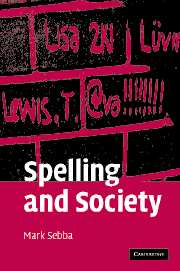Book contents
- Frontmatter
- Contents
- Illustrations
- Maps
- Diagrams
- Tables
- Acknowledgements
- Note on transcription
- 1 Map showing location of languages in Europe mentioned in this book
- 2 Map showing location of languages outside Europe mentioned in this book
- Introduction: society and orthography
- 1 Approaching orthography
- 2 Orthography as social practice
- 3 Language contact, linguists and the emergence of orthographies
- 4 ‘Postcolonial’ Orthographies
- 5 Between language and dialect: orthography in unstandardised and standardising vernaculars
- 6 Reform or revolution: where angels fear to tread
- 7 Why do we spell?
- Glossary
- References
- General index
- Index of language names
- Index of surnames
3 - Language contact, linguists and the emergence of orthographies
Published online by Cambridge University Press: 22 September 2009
- Frontmatter
- Contents
- Illustrations
- Maps
- Diagrams
- Tables
- Acknowledgements
- Note on transcription
- 1 Map showing location of languages in Europe mentioned in this book
- 2 Map showing location of languages outside Europe mentioned in this book
- Introduction: society and orthography
- 1 Approaching orthography
- 2 Orthography as social practice
- 3 Language contact, linguists and the emergence of orthographies
- 4 ‘Postcolonial’ Orthographies
- 5 Between language and dialect: orthography in unstandardised and standardising vernaculars
- 6 Reform or revolution: where angels fear to tread
- 7 Why do we spell?
- Glossary
- References
- General index
- Index of language names
- Index of surnames
Summary
The role of bilinguals in the development of orthographies
Estonian is a Uralic language, closely related to Finnish, which today has around one million speakers (www.ethnologue.com) and an extensive literature including a wide range of different genres. Estonian has been a written language since the thirteenth century, if we count the earliest fragmentary data. By the end of the eighteenth century, according to Kurman (1968) the literature of Estonia included songs, poems, dialogues, stories, riddles, a medical handbook, a Bible and numerous texts of a religious nature.
It comes then as something of a shock to read, in the third chapter of Kurman's history of written Estonian, that the Estonian ‘writer, clergyman and linguist’ O. W. Masing (1763–1832), was ‘the first literate who also had a thorough mastery of the Estonian language’ (Kurman 1968: 21).
The first six centuries of the development of written Estonian had, it turns out, been in the hands of individuals who lacked ‘a thorough mastery’ of the language. ‘Estonians’ they may have been (though in some cases they were not); but for the most part they were German by education and literacy. This certainly left its mark on the language: indeed, Kurman (1968: 9) remarks that ‘the written Estonian of 1690 might be thought of as a language which was poured into the mold of German’ with respect to syntax, lexis and orthography.
Orthographic changes to Estonian since then have eliminated many of the German characteristics of the spelling.
- Type
- Chapter
- Information
- Spelling and SocietyThe Culture and Politics of Orthography around the World, pp. 58 - 80Publisher: Cambridge University PressPrint publication year: 2007



